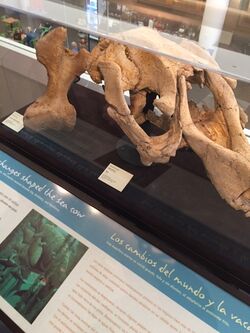Biology:Cuesta sea cow
| Cuesta sea cow | |
|---|---|

| |
| Skull of Hydrodamalis cuestae at San Diego Natural History Museum | |
| Scientific classification | |
| Domain: | Eukaryota |
| Kingdom: | Animalia |
| Phylum: | Chordata |
| Class: | Mammalia |
| Order: | Sirenia |
| Family: | Dugongidae |
| Genus: | †Hydrodamalis |
| Species: | †H. cuestae
|
| Binomial name | |
| †Hydrodamalis cuestae Domning, 1978
| |
| Synonyms | |
|
?†H. spissa Furusawa, 1988 | |
The Cuesta sea cow (Hydrodamalis cuestae) is an extinct herbivorous marine mammal and is the direct ancestor of the Steller's sea cow (Hydrodamalis gigas). They reached up to 9 metres (30 ft) in length, making them among the biggest sirenians to have ever lived. They were first described in 1978 by Daryl Domning when fossils in California were unearthed. Its appearance and behavior are largely based on that of the well-documented Steller's sea cow, which, unlike the Cuesta sea cow, lived into modern times and was well-described.
Taxonomy and extinction
The fossils of the Cuesta sea cow were first discovered in the Late Pliocene sediment formations of Pismo Beach, California in 1978, and successive finds of the species were unearthed elsewhere in California.[2] In 1988, fossils of sea cows were discovered in Hokkaido that were originally assigned to the Takikawa sea cow (H. spissa),[3] a newly-described species, but this is thought of by some scientists as a synonym of H. cuestae. It is uncertain whether or not H. spissa was simply a local variant of H. cuestae or a completely separate lineage.[3] The Steller's sea cow was apparently a direct descendant of the Cuesta sea cow.[4]
The Cuesta sea cow went extinct around 2½ million years ago. Its disappearance was likely linked to the onset of the Quaternary glaciation; the availability of the sea cows’ main food source, seagrasses, likely decreased due to the cooling of the oceans, disappearing to the point where the sea cow’s entire species simply could not sustain itself. In addition, the Cuesta sea cow was not adapted to colder waters; those animals that did survive probably became the ancient ancestors of the Steller's sea cow.[2]
Biology and behavior
The Cuesta sea cow, like the Steller's sea cow, or even modern manatees, was probably gregarious and lived in small family groups for relative safety. Their bones were dense, and served as a sort of “ballast” to prevent their large bodies from floating, a likely adaptation due to their constant grazing of seagrasses on the shallow ocean floor. Seagrasses and other marine plants were likely their preferred foods. Cuesta sea cows are thought to have 'walked' along the shallow coastal seafloor using their front limbs, as well as their powerful tail fin for propulsion. It has been speculated that, like Steller's sea cows and other sirenians, the front limbs were used as a holdfast. The Cuesta sea cow was among the largest of the sirenians to have ever lived, reaching up to 9 metres (30 ft) in length and possibly 10 tonnes (11 short tons). The body was fusiform, tapered at both the head and tail.[2][5]
See also
- Steller's sea cow
- Takikawa sea cow
- Hydrodamalinae
References
- ↑ Furusawa, Hitoshi (2004). "A phylogeny of the North Pacific Sirenia (Dugongidae: Hydrodamalinae) based on a comparative study of endocranial casts". Paleontological Research 8 (2): 91–98. doi:10.2517/prpsj.8.91.
- ↑ Jump up to: 2.0 2.1 2.2 Domning, Daryl P. (1978). "An Ecological Model for Late Tertiary Sirenian Evolution in the North Pacific Ocean". Systematic Zoology 25 (4): 352–362. doi:10.2307/2412510.
- ↑ Jump up to: 3.0 3.1 Furusawa, H. (1988). A new species of hydrodamaline Sirenia from Hokkaido, Japan. Takikawa Museum of Art and Natural History. pp. 1–73.
- ↑ Marsh, Helene; O'Shea, Thomas J.; Reynolds III, John E. (2011). "Steller's sea cow: discovery, biology and exploitation of a relict giant sirenian". Ecology and Conservation of the Sirenia: Dugongs and Manatees. New York: Cambridge University Press. pp. 18–35. ISBN 978-0-521-88828-8. https://books.google.com/books?id=7pQgAwAAQBAJ&pg=PA76.
- ↑ "Hydrodamalis cuestae" (in Russian). Age of Mammals. 2013. http://age-of-mammals.ucoz.ru/index/hydrodamalis_cuesta/0-36.
Wikidata ☰ Q9295375 entry
 |

